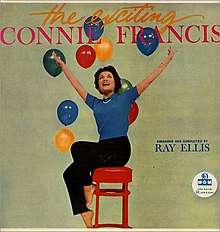

| The Exciting Connie Francis | ||||
|---|---|---|---|---|
 | ||||
| Studio album by | ||||
| Released | March 1959 | |||
| Recorded | January 14, 1959 February 1, 1959 February 11, 1959 February 18, 1959 | |||
| Genre | Pop | |||
| Length | 34:54 | |||
| Label | MGM E-3761 (mono)/SE-3761 (stereo) | |||
| Producer | Ray Ellis, Harry Myerson | |||
| Connie Francis chronology | ||||
| ||||
The Exciting Connie Francis is a studio album recorded by American pop singer Connie Francis.[1] It is the second album Francis cut for MGM Records.
After her breakthrough in early 1958 with her single Who's Sorry Now?, a rock 'n' roll oriented version of the 1923 standard, and a subsequent album of the same title, Francis chose to take a more adult approach to her second album. For The Exciting Connie Francis, she chose twelve American standards. Francis clearly marked the album as a concept album by dividing it into two sections with different moods: Side A is filled with songs differing between mid-tempo and up-tempo, while Side B consists solely of ballads.
The album was released in March 1959 on MGM Records 12" Album E-3761 (mono edition) and SE-3761 (stereo edition). It was repackaged and re-released in March 1962.
| # | Title | Songwriter | Length |
|---|---|---|---|
| 1. | "Come Rain or Come Shine" | Harold Arlen, Johnny Mercer | 2.20 |
| 2. | "Hallelujah, I Love Him So" | Ray Charles | 3.00 |
| 3. | "All By Myself" | Irving Berlin | 2.32 |
| 4. | "Rock-a-Bye Your Baby with a Dixie Melody" | Jean Schwartz, Sam M. Lewis, Joe Young | 2.31 |
| 5. | "There Will Never Be Another You" | Harry Warren, Mack Gordon | 1.55 |
| 6. | "The Song Is Ended (But the Melody Lingers On)" | Irving Berlin, Beda Loehner | 2.04 |
| # | Title | Songwriter | Length |
|---|---|---|---|
| 1. | "Time After Time" | Jule Styne, Sammy Cahn | 3.15 |
| 2. | "How Did He Look?" | Abner Silver, Gladys Shelley | 3.39 |
| 3. | "Hold Me, Thrill Me, Kiss Me" | Harry Noble | 3.44 |
| 4. | "That's All" | Alan Brandt, Bob Haymes | 3.22 |
| 5. | "Blame It on My Youth" | Oscar Levant, Edward Heyman | 2.56 |
| 6. | "Melancholy Serenade" | Jackie Gleason, Duke Enston | 3.36 |